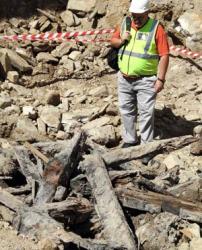09 FEVRIER
INSTITUT SUPERIEUR D’ANTHROPOLOGIE INDI-UNI :
INSCRIPTION 2012 / 2 COURS A DISTANCE
REGISTRATION 2012 /2 ONLINE COURSES
FRANCE –  Marseille - Des recherches archéologiques inédites sont menées actuellement dans le bassin d'eau du Vieux-Port, dans le cadre du projet de semi-piétonnisation. A l'emplacement des futures estacades, les reconnaissances sont effectuées avec une pelle mécanique. Elle explore les sédiments déposés entre 5 et 9 mètres de profondeur. « Le Vieux-Port n'a jamais fait l'objet de recherches archéologiques, explique Frédéric Leroy, le directeur adjoint pour la recherche archéologique préventive à la Drassm. Les fouilles menées à Marseille depuis 30 ans ont montré la richesse de la constitution de la ville ». Au collège Vieux-Port, des vestiges de l'époque grecque archaïque ont été découverts. Autour du Lacydon, un amas de coquilles d'huîtres préalablement mangées date de l'âge du bronze. « Une découverte plus ancienne que Marseille », note Nicolas Weydert, le responsable des opérations à l'institut national de recherches archéologiques préventives (Inrap). Il y a deux ans, 18 amphores avaient également été trouvées lors de la creusée d'une tranchée de 4 mètres de profondeur, « entre le Fort Saint-Jean et la Major, précise Frédéric Leroy. Or, on pensait qu'à cet endroit il n'y avait pas de port ». Le bassin du Vieux-Port, en l'état, n'est rempli d'eau que depuis 5 000 ans. « Le dernier quai connu se trouvait au niveau de la deuxième zone d'immeubles Pouillon », côté mairie, raconte Nicolas Weydert. Alors, pourquoi ne pas y trouver « une épave médiévale » engloutie ou « un campement paléolithique » ? Si ce rêve d'archéologue se réalise, les fouilles qui devraient se terminer le 24 février, seraient évidemment prolongées au-delà, bousculant le calendrier des travaux du Vieux-Port.
Marseille - Des recherches archéologiques inédites sont menées actuellement dans le bassin d'eau du Vieux-Port, dans le cadre du projet de semi-piétonnisation. A l'emplacement des futures estacades, les reconnaissances sont effectuées avec une pelle mécanique. Elle explore les sédiments déposés entre 5 et 9 mètres de profondeur. « Le Vieux-Port n'a jamais fait l'objet de recherches archéologiques, explique Frédéric Leroy, le directeur adjoint pour la recherche archéologique préventive à la Drassm. Les fouilles menées à Marseille depuis 30 ans ont montré la richesse de la constitution de la ville ». Au collège Vieux-Port, des vestiges de l'époque grecque archaïque ont été découverts. Autour du Lacydon, un amas de coquilles d'huîtres préalablement mangées date de l'âge du bronze. « Une découverte plus ancienne que Marseille », note Nicolas Weydert, le responsable des opérations à l'institut national de recherches archéologiques préventives (Inrap). Il y a deux ans, 18 amphores avaient également été trouvées lors de la creusée d'une tranchée de 4 mètres de profondeur, « entre le Fort Saint-Jean et la Major, précise Frédéric Leroy. Or, on pensait qu'à cet endroit il n'y avait pas de port ». Le bassin du Vieux-Port, en l'état, n'est rempli d'eau que depuis 5 000 ans. « Le dernier quai connu se trouvait au niveau de la deuxième zone d'immeubles Pouillon », côté mairie, raconte Nicolas Weydert. Alors, pourquoi ne pas y trouver « une épave médiévale » engloutie ou « un campement paléolithique » ? Si ce rêve d'archéologue se réalise, les fouilles qui devraient se terminer le 24 février, seraient évidemment prolongées au-delà, bousculant le calendrier des travaux du Vieux-Port.
http://www.20minutes.fr/article/876272/partie-bassin-exploree
BULGARIE – 
 - Veliko Tarnovo - Mural paintings, discovered during the excavation works in the Church of Saints Peter and Paul, Veliko Tarnovo, in 2011 are presented today by archaeologist Prof Nikolay Ovcharov. The mural paintings were discovered in June 2011, during the excavations of this church, which was the biggest of the Second Bulgarian Empire in the then-capital Tarnovo. We date the mural paintings back to the beginning of the 15th century (this was the second layer of mural paintings in the church). The mural paintings were taken down during the rehabilitation of the church, which took place in the 16th century. There was such a tradition, during the Middle Ages, when a rehabilitation took place – the old mural paintings were taken down from the walls, and were not thrown away, but rather placed in special pits, which we conditionally call “mural painting graves”. With our effective work in 2011, we managed to excavate nearly 15 human images. Some of them were of saints, along with scriptures written in Old Church Slavonic. Despite the fact that the church has managed to preserve many similar mural paintings, most of them have lost colour and their original colouring has faded. The ones we discovered underground, however, are in brilliant condition, as even the gold on them has been preserved. The artist, who wrote the scriptures, had created them with one of the most distinguished techniques of his time – the so-called late palaeological style. I would compare it to the greatest artists of the 14th and 15th century. This would be the style, which the most prominent early Renaissance artists like Giotto, had initially painted in.
- Veliko Tarnovo - Mural paintings, discovered during the excavation works in the Church of Saints Peter and Paul, Veliko Tarnovo, in 2011 are presented today by archaeologist Prof Nikolay Ovcharov. The mural paintings were discovered in June 2011, during the excavations of this church, which was the biggest of the Second Bulgarian Empire in the then-capital Tarnovo. We date the mural paintings back to the beginning of the 15th century (this was the second layer of mural paintings in the church). The mural paintings were taken down during the rehabilitation of the church, which took place in the 16th century. There was such a tradition, during the Middle Ages, when a rehabilitation took place – the old mural paintings were taken down from the walls, and were not thrown away, but rather placed in special pits, which we conditionally call “mural painting graves”. With our effective work in 2011, we managed to excavate nearly 15 human images. Some of them were of saints, along with scriptures written in Old Church Slavonic. Despite the fact that the church has managed to preserve many similar mural paintings, most of them have lost colour and their original colouring has faded. The ones we discovered underground, however, are in brilliant condition, as even the gold on them has been preserved. The artist, who wrote the scriptures, had created them with one of the most distinguished techniques of his time – the so-called late palaeological style. I would compare it to the greatest artists of the 14th and 15th century. This would be the style, which the most prominent early Renaissance artists like Giotto, had initially painted in.
http://www.focus-fen.net/index.php?id=f2792
AFRIQUE DU SUD –  Cape Town - The remains of a ship found at the V&A Waterfront in Cape Town has caused some excitement in academic circles and archaeologists want to examine it to determine its exact age. "The first priority is to get it out," archaeologist Liesbet Schietecatte told News24. She said that the team would work in partnership with the Iziko Museum in Cape Town to study remains of the ship and artefacts collected at the site. The remains of the ship are buried in a pit on the construction site of an office development at the No. 1 Silo at the V&A Waterfront and archaeologists have not been able to determine exactly the extent of the find. When all the loose parts have been removed, we will investigate see what is still left in situ, because we think that there is still some wood left the way the ship or boat got stuck on the sand," Schietecatte said. The approximately 8m long hull lies buried in beach sand close to where the tidal zone was, in the 1800s. Schietecatte, however, said it was difficult to pin down an exact date until the team has had more time to study it. "A guess now would be 19th century, but we will have to look at that again. It's like a jigsaw: We will put out all the pieces, clean them up, record them. See how they fit together and by the way the ship was constructed, we will probably be able to tell more."
Cape Town - The remains of a ship found at the V&A Waterfront in Cape Town has caused some excitement in academic circles and archaeologists want to examine it to determine its exact age. "The first priority is to get it out," archaeologist Liesbet Schietecatte told News24. She said that the team would work in partnership with the Iziko Museum in Cape Town to study remains of the ship and artefacts collected at the site. The remains of the ship are buried in a pit on the construction site of an office development at the No. 1 Silo at the V&A Waterfront and archaeologists have not been able to determine exactly the extent of the find. When all the loose parts have been removed, we will investigate see what is still left in situ, because we think that there is still some wood left the way the ship or boat got stuck on the sand," Schietecatte said. The approximately 8m long hull lies buried in beach sand close to where the tidal zone was, in the 1800s. Schietecatte, however, said it was difficult to pin down an exact date until the team has had more time to study it. "A guess now would be 19th century, but we will have to look at that again. It's like a jigsaw: We will put out all the pieces, clean them up, record them. See how they fit together and by the way the ship was constructed, we will probably be able to tell more."
VIDEO = http://www.youtube.com/watch?v=ilN4eI66bVc
http://www.news24.com/SciTech/News/Team-racing-to-dig-up-Waterfront-ship-20120209
INDE –  Aradi - Shivratri is round the corner but little has been done to give a facelift to the Akhandalamani temple. The 14th century shrine has a defunct drainage system and electrical wiring, cracks have developed in its stone wall and roof, water is seeping into the sanctum sanctorum and the pond is polluted. These have been affecting the daily rituals. The make-shift shops in and around the temple have encroached upon a lot of area hampering the movement of devotees. This is prove to be a big problem during Shivratri when many will throng the temple. "The dumping of garbage in front of the temple is also very repelling. The temple management is also to be blamed for it. "Though the temple management earns more than Rs 10 lakh by selling fish from the temples' pond, it does not clean the pond. This despite the pond being considered holy and the water is used for temple rituals. Devotees also bath in it.
Aradi - Shivratri is round the corner but little has been done to give a facelift to the Akhandalamani temple. The 14th century shrine has a defunct drainage system and electrical wiring, cracks have developed in its stone wall and roof, water is seeping into the sanctum sanctorum and the pond is polluted. These have been affecting the daily rituals. The make-shift shops in and around the temple have encroached upon a lot of area hampering the movement of devotees. This is prove to be a big problem during Shivratri when many will throng the temple. "The dumping of garbage in front of the temple is also very repelling. The temple management is also to be blamed for it. "Though the temple management earns more than Rs 10 lakh by selling fish from the temples' pond, it does not clean the pond. This despite the pond being considered holy and the water is used for temple rituals. Devotees also bath in it.
http://timesofindia.indiatimes.com/city/bhubaneswar/Akhandalamani-temple-needs-a-facelift-ahead-of-Shivaratri/articleshow/11811823.cms
INDE – Hyderabad - The Veyikaalla (1,000-pillar) mandapam row has come back to haunt theTirumala Tirupati Devasthanams (TTD). Days after Tridandi Chinna Ramanuja Jeeyar Swami launched a vitriolic attack on TTD for not rebuilding the famous mandapam, the state archaeology department has written a strong letter to the temple board saying that the demolition of the structure was arbitrary and illegal and that it should be rebuild at all costs. The 550-year-old structure was demolished in 2003. The mandapam was built in 1464 by Saluva Malla Devaraya.
http://timesofindia.indiatimes.com/city/hyderabad/TTD-under-pressure-to-rebuild-mandapam/articleshow/11814761.cms
TURQUIE – Istanbul - Turkey is going to build the perfect replica of a Byzantine ship for scientific purposes. The copy of the medieval ship, nearly 10 metres long and more than 2.5 metres wide, will be put to sea next year under the name ''Yenikapi 12''. The ship will be the same type of one of the 36 that were found, along with thousands of other artifacts, during the ongoing excavations for the Istanbul underground that started in Yenikapi in 2004. The shipwrecks that were found on the coasts of Istanbul are estimated to have been constructed between the fifth and 10th century AD, are regarded as the world's largest shipwreck collection. The ships shed light on the construction technology that was used in the Byzantine era. Its structure, the researcher specified that ''the body of ship has been recorded with 3D technology. Each wooden detail on the surface of the boat was transferred to computer and we obtained a lot of information about its construction process. As a result of a three-year evaluation, the dimensions of Yenikapi 12 were determined. According to this data, a drawing of the boat has been made and illustrations and animations, showing its situation on the water, have been prepared.
http://www.ansamed.info/ansamed/en/news/nations/turkey/2012/02/09/visualizza_new.html_76609546.html
CHINE – Xi’an - China's first archaeological museum will be built in Xi'an, capital of the northwestern Shaanxi Province this year, local authorities has said. The museum will aim to popularize knowledge of archaeology among common people and diversify China's museum types, said Zhao Rong, director of the provincial cultural relics bureau, at a provincial meeting attended by cultural relics officials. The museum is also likely to exhibit the process of archaeological excavation, archaeology technology, as well as ideas about archaeology, according to Wang Weilin, director of the Shaanxi Provincial Institute of Archaeology. The museum will consist of four major sections including a specimen exhibition area, archaeological materials showroom, public participation area, and culture industry area, Wang said. The museum is designed to cover 10 hectares in Qujiang, a southeastern district of Xi'an.
http://english.cri.cn/6909/2012/02/09/3124s680062.htm
USA – Griswold - The archaeology of vampires in Southeastern Connecticut.
The story began in the fall of 1990, when a sand and gravel operation in Griswold accidently uncovered an 18th- century farming family cemetery. The state archaeologist mobilized to rescue remains endangered by collapse from the gravel bank. Twenty-nine individuals were recovered and analyzed. Instead of being in anatomical position within the coffin feature, one individual was totally re-arranged in the grave. Searching for an explanation led to the trail of the New England “Vampire” folk belief.
http://www.theday.com/apps/pbcs.dll/dcce?Site=NL&Date=20111009&Module=1&Kategori=FRONTPAGE&Class=11&Type=APPROVED&ID=3885222&Selected=7&occurDate=20120215